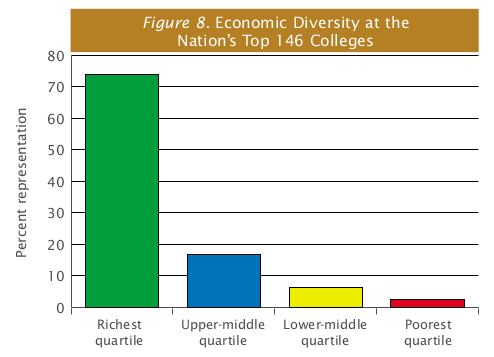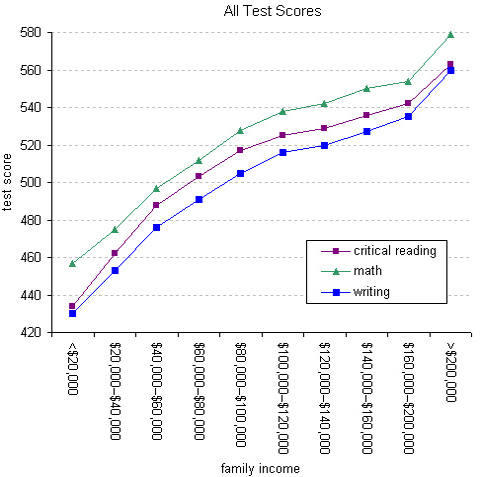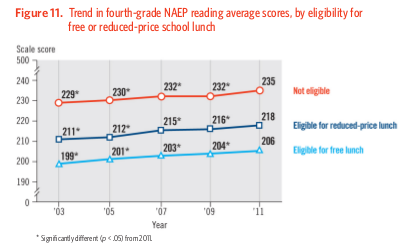Among other things, many of those concerned about student debt and the rising cost of college argue that those things account for why poor kids do not go to college. College is too expensive, and so poor kids cannot afford to go. As I have stated before, my view is that the lesser qualifications of poor kids explains the class disparity in higher education much better than cost does. Here I rehearse the qualifications argument again, and then explain the problem with cost-focused theories by drawing upon new research by Catherine Hoxby.
The following graph encapsulates what this dispute is about. I and others are interested in explaining why this graph looks the way it looks, instead of showing all four bars hovering around 25%.

If you are being serious, you have to start by looking at the differing academic achievement levels of individuals from each class prior to college. And those achievement levels, as is often publicized, are majorly divergent. The following graphs present just a snapshot of the relevant data. The first is SAT scores broken down by household income. The second is dropout rates broken down by income (poor is bottom 20%, rich is top 20%, middle is everyone else). And the third is NAEP test scores broken down by eligibility for free or reduced-price school lunches.




This data could go on and on forever. There is so much of it that it is surprising how rarely those who make the college costs arguments ever mention it. I take it as very uncontentious that by the time college rolls around, poor kids are, in aggregate, majorly behind rich kids. There is a dispute about what drives the differential achievement in pre-college schooling. I say it is primarily the effects of poverty, but whatever it is, it certainly isn’t the cost of college. So, the achievement gap goes a long way towards explaining why fewer poor kids are in college and why those that do attend college do so at less prestigious universities.
It does not explain all of the college difference though. Poor kids, on average, do worse in school, but that still leaves open the question of the exceptional poor kids. When we control for scores (only comparing rich and poor kids with the same achievement levels), poor kids still attend college at lower rates and attend worse colleges than they could get into. The proximate cause of this difference is that high-achieving poor kids systematically apply to schools ranked far below the schools their scores could get them into.
Using the grades and scores of poor kids as well as data on the median SAT scores of admitted students, Catherine Hoxby identifies how often high-achieving poor kids apply to “par” or better schools. That is, she identifies how often these kids apply to schools that their grades and scores indicate they would be a good fit for, as opposed to less selective colleges with lower bars for admission. It turns out that 82 percent of high-achieving poor kids do not apply to any par or above colleges. That is, they only apply to colleges where the median SAT scores of admitted students are well below their own scores.
So the proximate cause of poor kids going to worse or no colleges appears to be that they are not applying to the right places. But why not? This is where it seems like cost could come in as an explanation, but surprisingly no. As Catherine Hoxby shows, high-achieving poor kids systematically apply to schools ranked far below those their scores could get them into even when the higher-ranked schools would be cheaper.
It may surprise some that these higher-ranked schools can often be cheaper, but that is because few realize that the sticker price for college attendance (especially at high-ranked schools) does not tell you anything about what individuals will actually pay. And as it turns out, poor kids pay just a fraction of what rich kids pay.
Hoxby goes on to give a few explanations as to why poor kids fail to apply to par or better schools, but they all ultimately amount to the existence of a college admissions knowledge gap. For various reasons, poor kids do not understand the college admissions process as well as rich kids, and therefore do not understand what their achievement level qualifies them for, how much a school will actually cost them, and so on. This leads them to make sub-optimal decisions about whether and where to attend college.
So poor kids face two specific challenges well before cost even comes into the picture: the achievement gap and the knowledge gap. The achievement gap screens out the majority of poor kids and then the knowledge gap takes a second shot at the exceptional poor kids who manage to do well despite the achievement gap. Combined, these two gaps generate the imbalance identified in the first graph. None of this is to say cost means nothing: surely there are some marginal poor kids for whom cost (or more likely perceived cost) is the deciding factor on whether or where to attend college. But it’s almost certainly a trailing factor if one worth mentioning at all.